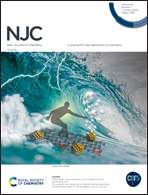Vitrimer enhanced carbazole-based organic room-temperature phosphorescent materials†
Abstract
Organic room-temperature phosphorescent (RTP) materials have promising applications, but due to the lack of inter-system scaling and susceptibility to non-radiative transition, they typically have low quantum yields (<2%) and short lifetimes (<1 s), and their performance is not comparable to that of traditional inorganic phosphorescent materials. In this paper, we designed two phosphorescent molecules (TPACZ and DMACZ) based on carbazole, incorporated them into a dynamic epoxy crosslinking network, and successfully obtained pure organic RTP vitrimers with high quantum yields (7.28%) and long phosphorescent lifetimes (1.689 s). Our study confirms the potential phosphorescent properties of both molecules and the contribution of the vitrimer's rigid cross-linked network to phosphorescent emission. We demonstrate the ability to reprocess the RTP vitrimer at high temperatures and retain phosphorescence emission properties after reprocessing. Furthermore, by adjusting the dopant molecules and the type of curing agent, the phosphorescence lifetime of the RTP vitrimers can be tailored, allowing for anti-counterfeiting applications. Our research offers a new strategy for the design of pure organic RTP materials for anti-counterfeiting and information applications.



 Please wait while we load your content...
Please wait while we load your content...